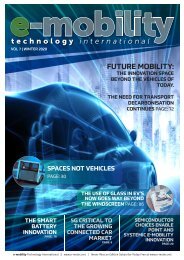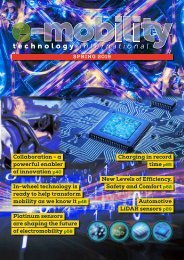E-mobility Technology Summer 2020
Engage with the innovators who are making the shift to electric vehicles a reality
Engage with the innovators who are making the shift to electric vehicles a reality
Create successful ePaper yourself
Turn your PDF publications into a flip-book with our unique Google optimized e-Paper software.
Electrically<br />
Mobile<br />
01<br />
CHARGING<br />
INFRASTRUCTURE<br />
Electric Mobility – The Infrastructure<br />
Perspective<br />
A lot has been written on the possibilities<br />
that electric <strong>mobility</strong> offers. In particular,<br />
micro <strong>mobility</strong> has been in the news a lot<br />
lately, especially with the current pandemic.<br />
We are presented a vision where electric<br />
scooter and e-bike sharing will revolutionise<br />
public transportation, eliminate cars in urban<br />
spaces and create green and pleasant cities.<br />
However, the infrastructure perspective<br />
is often missing from this narrative, despite<br />
accessible, smart charging offering huge<br />
potential to make electric, shared <strong>mobility</strong><br />
more convenient, more environmentally<br />
friendly and more cost effective.<br />
Thinking differently<br />
With personal internal combustion engine cars,<br />
we are all used to thinking a certain way about<br />
<strong>mobility</strong>. We drive until the tank is empty, fill<br />
up, and carry on. Except on long trips or for<br />
frequent drivers, filling up happens maybe once<br />
a week. Electric <strong>mobility</strong> forces a change in<br />
thinking, as now the vehicle is filled up when not<br />
in use, so you start the ride with a “full tank”.<br />
Shared micro <strong>mobility</strong> requires a further<br />
change. Now the vehicle is used much more<br />
frequently, and charging is the necessary<br />
annoyance that allows the user to do what they<br />
actually want, namely to be mobile. The vehicle<br />
is usually charged fully then used until empty, at<br />
which point it stands useless until it is charged<br />
again. For public sharing, dedicated personnel<br />
are required to organise charging or swap<br />
batteries. In private sharing, the user is required<br />
to invest their time finding a suitable place to<br />
plug in. A lot of activity in the background is<br />
needed to give the user that effortless ride.<br />
However, we at INTIS envisage smart<br />
infrastructure replacing that activity in the<br />
background. This requires accessible charging<br />
infrastructure allowing automatic opportunity<br />
charging, coupled with good use of data and<br />
communications. In this scenario, neither<br />
the user nor the operator need greatly<br />
concern themselves with making sure the<br />
vehicle gets its energy because that is taken<br />
care of by the infrastructure solution.<br />
Smart Services Provide Solutions,<br />
Not Just <strong>Technology</strong> – Commentary By<br />
The University Of Duisburg-Essen<br />
One area where the potential of electro<strong>mobility</strong><br />
is becoming apparent is in intralogistics,<br />
although this potential is often inhibited by<br />
incorrect usage behaviour. Vehicles are plugged<br />
in to charge as often as possible to minimise<br />
down-time. This high charging frequency<br />
may be suitable for lithium-ion batteries, but<br />
it drastically reducing the lifetime of leadgel<br />
batteries which are still very common in<br />
industry. Even worse, fleets and equipment are<br />
not usually updated all at once, meaning a mix<br />
of battery types ends up being charged the<br />
same way by the same equipment. This leads<br />
to a high replacement rate with associated<br />
materials, time, and overhead costs.<br />
Smart Charging – A Real World Application<br />
The solution is smart charging in connection<br />
with a fleet management system, where the<br />
charging infrastructure identifies the vehicle and<br />
battery type, connects to the fleet management<br />
system and determines the optimal charging<br />
behaviour based on stored information and<br />
historic usage patterns. These usage patterns<br />
provide information about the expected duration<br />
and distance of the next drive, based on daily<br />
driving patterns, which allow the smart charging<br />
application to calculate whether the battery<br />
level is sufficient or the battery needs to be<br />
charged. The availability of good data to develop<br />
relevant information is crucial to the efficacy of<br />
smart charging.<br />
Smart, inductive charging system<br />
The project Smart Inductive Solutions, a spinoff<br />
of the university Duisburg-Essen in Germany, is<br />
developing a system to address this issue. A datadriven<br />
approach is used to focus on value propositions<br />
for the individual customer, with very promising<br />
results coming from first tests currently running under<br />
real-world conditions. The gathering, transmission,<br />
and evaluation of required data in combination with<br />
wireless charging are key components of the project.<br />
The system consists of several core sub-systems,<br />
principally the charging infrastructure, the application<br />
server and multiple client workstations, as displayed<br />
in figure 2. Besides providing energy, the charging<br />
infrastructure provides bidirectional communication<br />
between the vehicles and the back-end. When a<br />
vehicle is parked, the charging infrastructure identifies<br />
this vehicle and loads the applicable battery data<br />
from the application server. The application server<br />
keeps track of each charging process and determines<br />
e-<strong>mobility</strong> <strong>Technology</strong> International 4 5<br />
<strong>Summer</strong> <strong>2020</strong>









